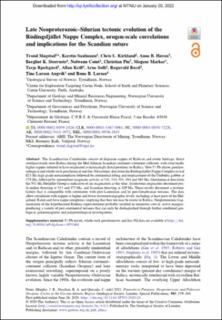| dc.contributor.author | Slagstad, Trond | |
| dc.contributor.author | Saalmann, Kerstin | |
| dc.contributor.author | Kirkland, CL | |
| dc.contributor.author | Høyen, Anne Bruland | |
| dc.contributor.author | Storruste, Bergliot K. | |
| dc.contributor.author | Coint, Nolwenn | |
| dc.contributor.author | Pin, Christian | |
| dc.contributor.author | Marker, Mogens | |
| dc.contributor.author | Bjerkgård, Terje | |
| dc.contributor.author | Krill, Allan George | |
| dc.contributor.author | Boyd, Rognvald | |
| dc.contributor.author | Angvik, Tine Larsen | |
| dc.contributor.author | B. Larsen, Rune | |
| dc.date.accessioned | 2022-01-26T13:34:50Z | |
| dc.date.available | 2022-01-26T13:34:50Z | |
| dc.date.created | 2022-01-20T10:33:12Z | |
| dc.date.issued | 2021 | |
| dc.identifier.citation | Geological Society Special Publication. 2021, 503, 279-304. | en_US |
| dc.identifier.issn | 0305-8719 | |
| dc.identifier.uri | https://hdl.handle.net/11250/2839483 | |
| dc.description.abstract | The Scandinavian Caledonides consist of disparate nappes of Baltican and exotic heritage, thrust southeastwards onto Baltica during the Mid-Silurian Scandian continent–continent collision, with structurally higher nappes inferred to have originated at increasingly distal positions to Baltica. New U–Pb zircon geochronological and whole-rock geochemical and Sm–Nd isotopic data from the Rödingsfjället Nappe Complex reveal 623 Ma high-grade metamorphism followed by continental rifting and emplacement of the Umbukta gabbro at 578 Ma, followed by intermittent magmatic activity at 541, 510, 501, 484 and 465 Ma. Geochemical data from the 501 Ma Mofjellet Group is indicative of arc magmatism at this time. Syntectonic pegmatites document pre-Scandian thrusting at 515 and 475 Ma, and Scandian thrusting at 429 Ma. These results document a tectonic history that is compatible with correlation with peri-Laurentian and/or peri-Gondwanan terranes. The data allow correlation with nappes at higher and lower tectonostratigraphic levels, including at least parts of the Helgeland, Kalak and Seve nappe complexes, implying that they too may be exotic to Baltica. Neoproterozoic fragmentation of the hypothesized Rodinia supercontinent probably resulted in numerous coeval, active margins, producing a variety of peri-continental terranes that can only be distinguished through further combined geological, palaeomagnetic and palaeontological investigations. | en_US |
| dc.language.iso | eng | en_US |
| dc.publisher | The Geological Society of London | en_US |
| dc.rights | Navngivelse 4.0 Internasjonal | * |
| dc.rights.uri | http://creativecommons.org/licenses/by/4.0/deed.no | * |
| dc.title | Late Neoproterozoic–Silurian tectonic evolution of the Rödingsfjället Nappe Complex, orogen-scale correlations and implications for the Scandian suture | en_US |
| dc.type | Peer reviewed | en_US |
| dc.type | Journal article | en_US |
| dc.description.version | publishedVersion | en_US |
| dc.source.pagenumber | 279-304 | en_US |
| dc.source.volume | 503 | en_US |
| dc.source.journal | Geological Society Special Publication | en_US |
| dc.identifier.doi | https://doi.org/10.1144/SP503-2020-10 | |
| dc.identifier.cristin | 1985820 | |
| cristin.ispublished | true | |
| cristin.fulltext | original | |
| cristin.qualitycode | 1 | |

